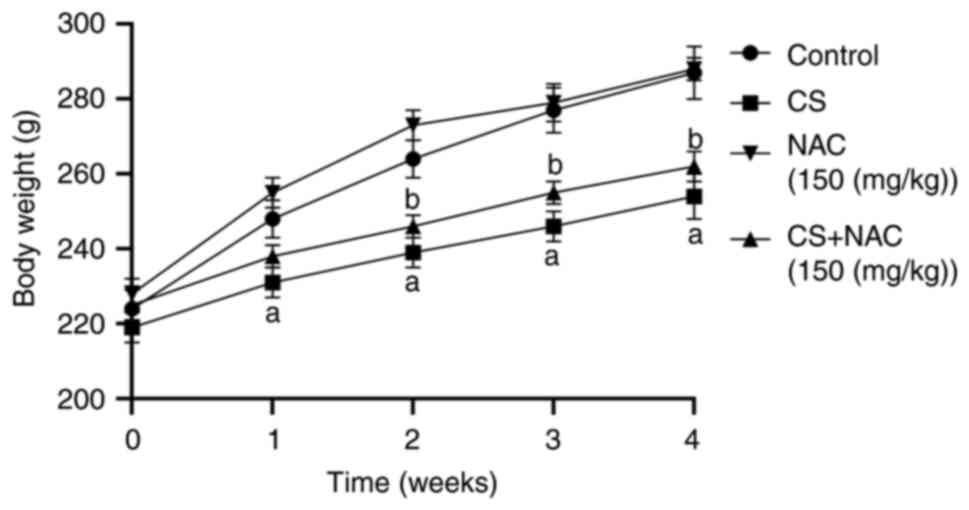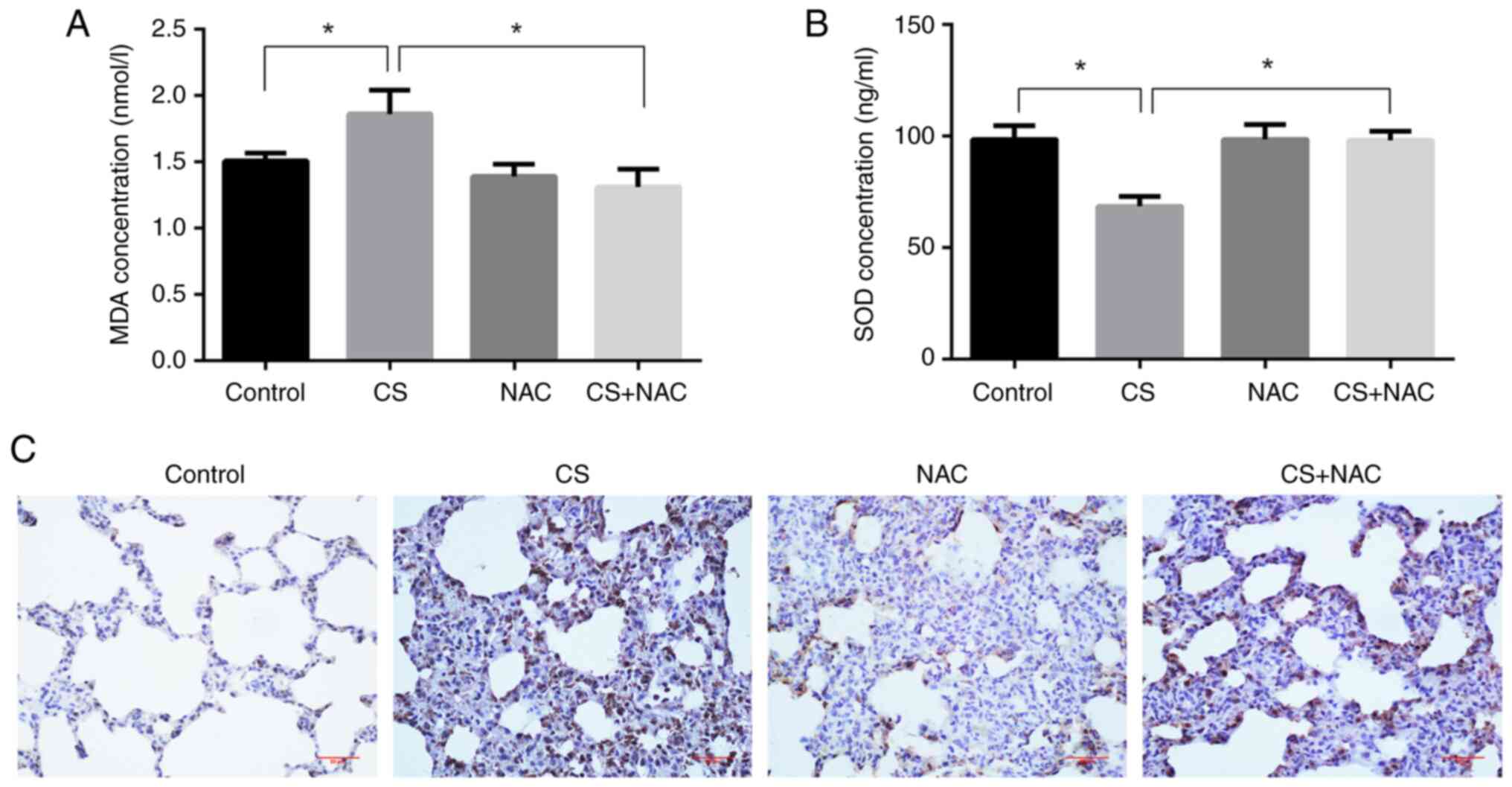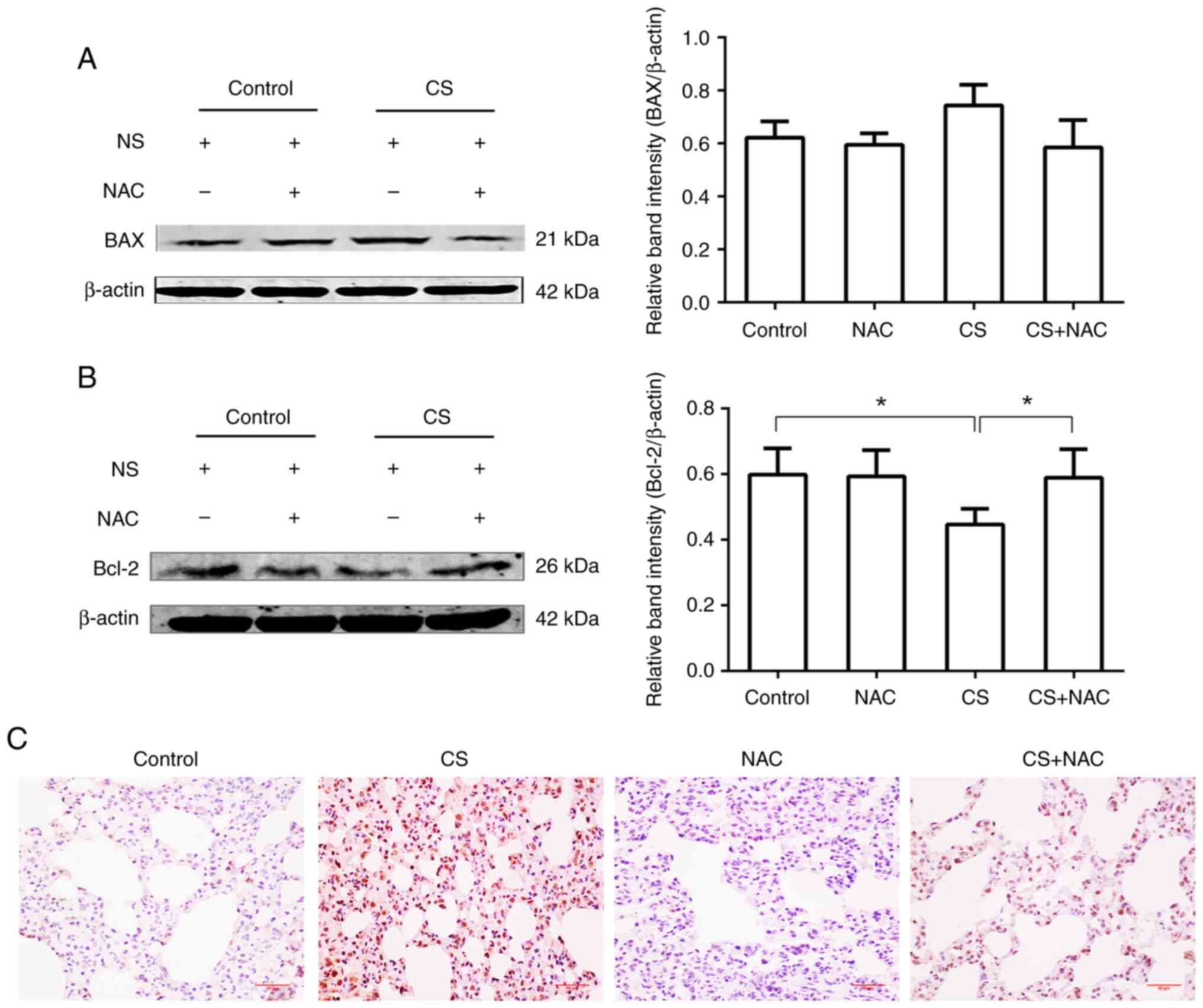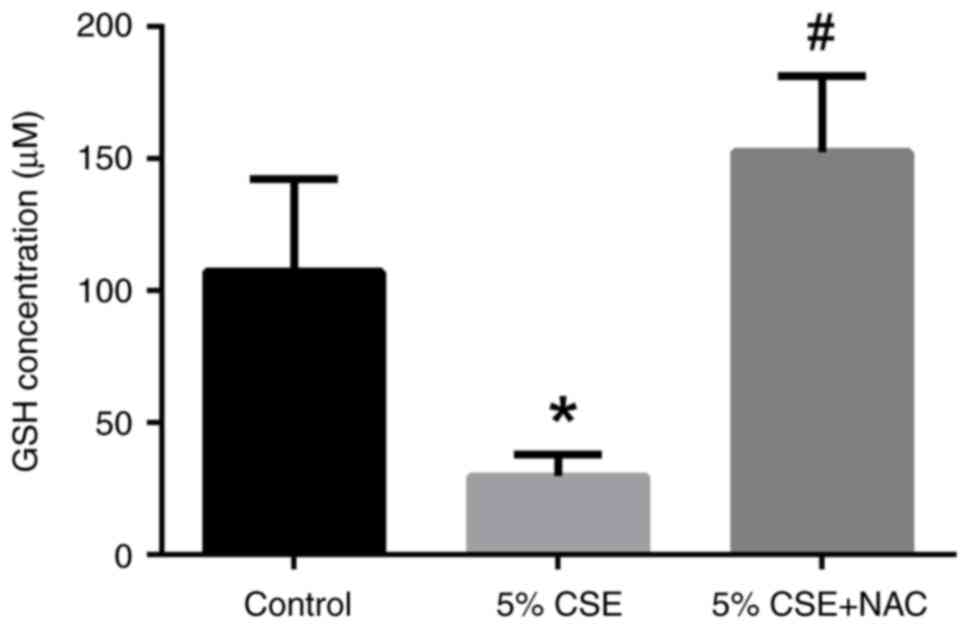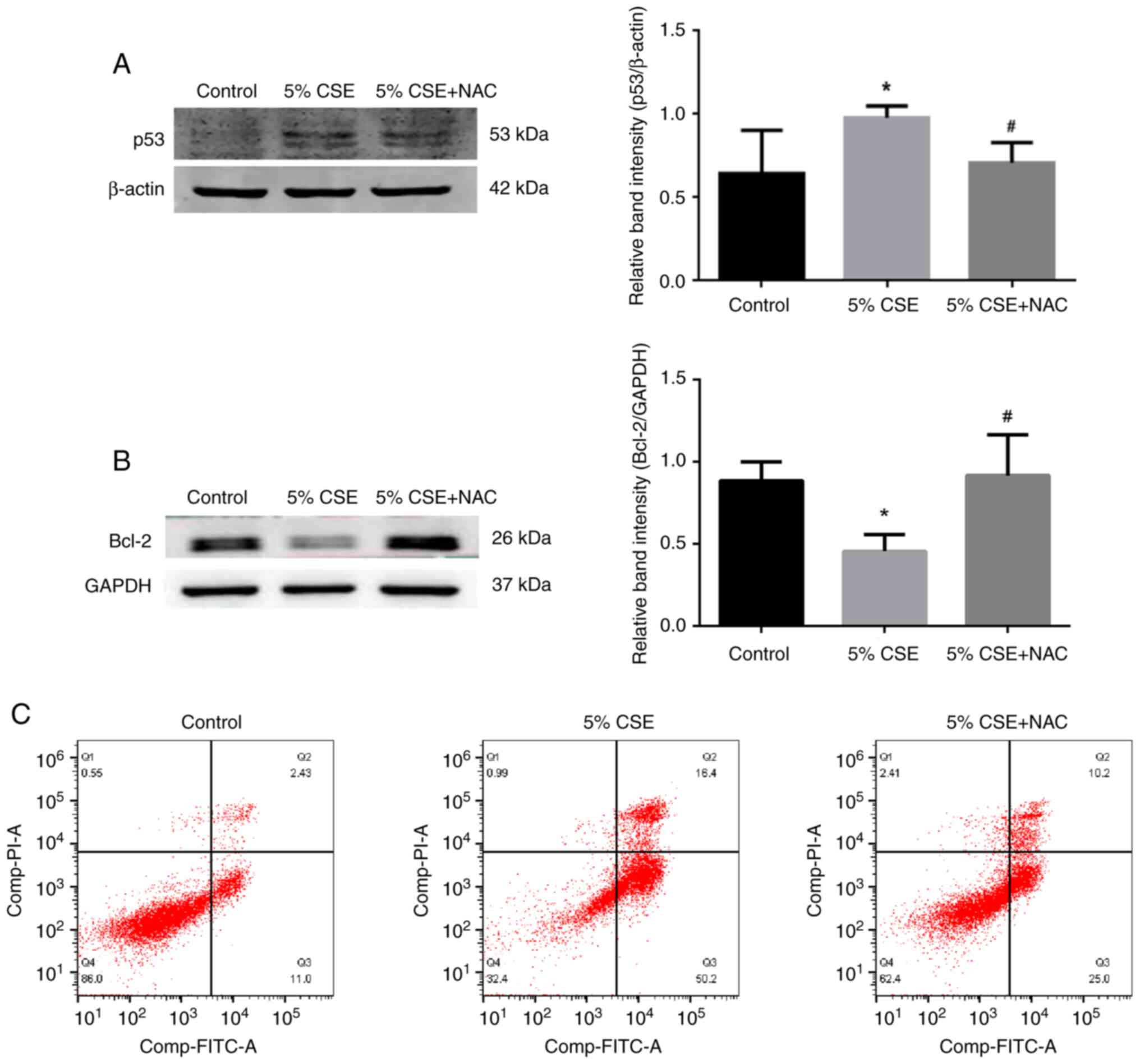|
1
|
Kahnert K, Jörres RA, Behr J and Welte T:
The diagnosis and treatment of COPD and its comorbidities. Dtsch
Arztebl Int. 120:434–444. 2023.PubMed/NCBI
|
|
2
|
Song Q, Chen P and Liu XM: The role of
cigarette smoke-induced pulmonary vascular endothelial cell
apoptosis in COPD. Respir Res. 22:392021. View Article : Google Scholar : PubMed/NCBI
|
|
3
|
Devulder JV: Unveiling mechanisms of lung
aging in COPD: A promising target for therapeutics development.
Chin Med J Pulm Crit Care Med. 2:133–141. 2024. View Article : Google Scholar : PubMed/NCBI
|
|
4
|
Kaur M, Chandel J, Malik J and Naura AS:
Particulate matter in COPD pathogenesis: An overview. Inflamm Res.
71:797–815. 2022. View Article : Google Scholar : PubMed/NCBI
|
|
5
|
Chen L, Zhu D, Huang J, Zhang H, Zhou G
and Zhong X: Identification of hub genes associated with COPD
through integrated bioinformatics analysis. Int J Chron Obstruct
Pulmon Dis. 17:439–456. 2022. View Article : Google Scholar : PubMed/NCBI
|
|
6
|
Prieux R, Eeman M, Rothen-Rutishauser B
and Valacchi G: Mimicking cigarette smoke exposure to assess
cutaneous toxicity. Toxicol In Vitro. 62:1046642020. View Article : Google Scholar : PubMed/NCBI
|
|
7
|
Fischer BM, Voynow JA and Ghio AJ: COPD:
Balancing oxidants and antioxidants. Int J Chron Obstruct Pulmon
Dis. 10:261–276. 2015. View Article : Google Scholar : PubMed/NCBI
|
|
8
|
Woźniak A, Górecki D, Szpinda M,
Mila-Kierzenkowska C and Woźniak B: Oxidant-antioxidant balance in
the blood of patients with chronic obstructive pulmonary disease
after smoking cessation. Oxid Med Cell Longev. 2013:8970752013.
View Article : Google Scholar : PubMed/NCBI
|
|
9
|
Sies H and Jones DP: Reactive oxygen
species (ROS) as pleiotropic physiological signalling agents. Nat
Rev Mol Cell Biol. 21:363–383. 2020. View Article : Google Scholar : PubMed/NCBI
|
|
10
|
Barnes PJ: Oxidative stress in chronic
obstructive pulmonary disease. Antioxidants (Basel). 11:9652022.
View Article : Google Scholar : PubMed/NCBI
|
|
11
|
Cha SR, Jang J, Park SM, Ryu SM, Cho SJ
and Yang SR: Cigarette smoke-induced respiratory response: Insights
into cellular processes and biomarkers. Antioxidants (Basel).
12:12102023. View Article : Google Scholar : PubMed/NCBI
|
|
12
|
Paintlia MK, Paintlia AS, Contreras MA,
Singh I and Singh AK: Lipopolysaccharide-induced peroxisomal
dysfunction exacerbates cerebral white matter injury: Attenuation
by N-acetyl cysteine. Exp Neurol. 210:560–576. 2008. View Article : Google Scholar : PubMed/NCBI
|
|
13
|
Aldini G, Altomare A, Baron G, Vistoli G,
Carini M, Borsani L and Sergio F: N-Acetylcysteine as an
antioxidant and disulphide breaking agent: The reasons why. Free
Radic Res. 52:751–762. 2018. View Article : Google Scholar : PubMed/NCBI
|
|
14
|
Pedre B, Barayeu U, Ezeriņa D and Dick TP:
The mechanism of action of N-acetylcysteine (NAC): The emerging
role of H(2)S and sulfane sulfur species. Pharmacol Ther.
228:1079162021. View Article : Google Scholar : PubMed/NCBI
|
|
15
|
Millea PJ: N-acetylcysteine: Multiple
clinical applications. Am Fam Physician. 80:265–269.
2009.PubMed/NCBI
|
|
16
|
Sanguinetti CM: N-acetylcysteine in COPD:
Why, how, and when? Multidiscip Respir Med. 11:82016. View Article : Google Scholar : PubMed/NCBI
|
|
17
|
Messier EM, Day BJ, Bahmed K, Kleeberger
SR, Tuder RM, Bowler RP, Chu HW, Mason RJ and Kosmider B:
N-Acetylcysteine protects murine alveolar type II cells from
cigarette smoke injury in a nuclear erythroid 2-related
factor-2-independent manner. Am J Respir Cell Mol Biol. 48:559–567.
2013. View Article : Google Scholar : PubMed/NCBI
|
|
18
|
Cazzola M, Page CP, Wedzicha JA, Celli BR,
Anzueto A and Matera MG: Use of thiols and implications for the use
of inhaled corticosteroids in the presence of oxidative stress in
COPD. Respir Res. 24:1942023. View Article : Google Scholar : PubMed/NCBI
|
|
19
|
Burkhardt BR, Lyle R, Qian K, Arnold AS,
Cheng H, Atkinson MA and Zhang YC: Efficient delivery of siRNA into
cytokine-stimulated insulinoma cells silences Fas expression and
inhibits Fas-mediated apoptosis. FEBS Lett. 580:553–560. 2006.
View Article : Google Scholar : PubMed/NCBI
|
|
20
|
Murphy MP, Bayir H, Belousov V, Chang CJ,
Davies KJA, Davies MJ, Dick TP, Finkel T, Forman HJ,
Janssen-Heininger Y, et al: Guidelines for measuring reactive
oxygen species and oxidative damage in cells and in vivo. Nat
Metab. 4:651–662. 2022. View Article : Google Scholar : PubMed/NCBI
|
|
21
|
Dang X, He B, Ning Q, Liu Y, Guo J, Niu G
and Chen M: Alantolactone suppresses inflammation, apoptosis and
oxidative stress in cigarette smoke-induced human bronchial
epithelial cells through activation of Nrf2/HO-1 and inhibition of
the NF-κB pathways. Respir Res. 21:952020. View Article : Google Scholar : PubMed/NCBI
|
|
22
|
Vijayan VK: Chronic obstructive pulmonary
disease. Indian J Med Res. 137:251–269. 2013.PubMed/NCBI
|
|
23
|
Salvi SS and Barnes PJ: Chronic
obstructive pulmonary disease in non-smokers. Lancet. 374:733–743.
2009. View Article : Google Scholar : PubMed/NCBI
|
|
24
|
Martinez FJ, Donohue JF and Rennard SI:
The future of chronic obstructive pulmonary disease
treatment-difficulties of and barriers to drug development. Lancet.
378:1027–1037. 2011. View Article : Google Scholar : PubMed/NCBI
|
|
25
|
Upadhyay P, Wu CW, Pham A, Zeki AA, Royer
CM, Kodavanti UP, Takeuchi M, Bayram H and Pinkerton KE: Animal
models and mechanisms of tobacco smoke-induced chronic obstructive
pulmonary disease (COPD). J Toxicol Environ Health B Crit Rev.
26:275–305. 2023. View Article : Google Scholar : PubMed/NCBI
|
|
26
|
Henrot P, Blervaque L, Dupin I, Zysman M,
Esteves P, Gouzi F, Hayot M, Pomiès P and Berger P: Cellular
interplay in skeletal muscle regeneration and wasting: Insights
from animal models. J Cachexia Sarcopenia Muscle. 14:745–757. 2023.
View Article : Google Scholar : PubMed/NCBI
|
|
27
|
Mineur YS, Abizaid A, Rao Y, Salas R,
DiLeone RJ, Gündisch D, Diano S, De Biasi M, Horvath TL, Gao XB and
Picciotto MR: Nicotine decreases food intake through activation of
POMC neurons. Science. 332:1330–1332. 2011. View Article : Google Scholar : PubMed/NCBI
|
|
28
|
Chen H, Hansen MJ, Jones JE, Vlahos R,
Bozinovski S, Anderson GP and Morris MJ: Cigarette smoke exposure
reprograms the hypothalamic neuropeptide Y axis to promote weight
loss. Am J Respir Crit Care Med. 173:1248–1254. 2006. View Article : Google Scholar : PubMed/NCBI
|
|
29
|
Jomova K, Raptova R, Alomar SY, Alwasel
SH, Nepovimova E, Kuca K and Valko M: Reactive oxygen species,
toxicity, oxidative stress, and antioxidants: Chronic diseases and
aging. Arch Toxicol. 97:2499–2574. 2023. View Article : Google Scholar : PubMed/NCBI
|
|
30
|
Boatright KM and Salvesen GS: Caspase
activation. Biochem Soc Symp. 233–242. 2003.PubMed/NCBI
|
|
31
|
Ruaro B, Salton F, Braga L, Wade B,
Confalonieri P, Volpe MC, Baratella E, Maiocchi S and Confalonieri
M: The history and mystery of alveolar epithelial type II cells:
Focus on their physiologic and pathologic role in lung. Int J Mol
Sci. 22:25662021. View Article : Google Scholar : PubMed/NCBI
|
|
32
|
Han S, Lee M, Shin Y, Giovanni R,
Chakrabarty RP, Herrerias MM, Dada LA, Flozak AS, Reyfman PA,
Khuder B, et al: Mitochondrial integrated stress response controls
lung epithelial cell fate. Nature. 620:890–897. 2023. View Article : Google Scholar : PubMed/NCBI
|
|
33
|
Baglole CJ, Bushinsky SM, Garcia TM, Kode
A, Rahman I, Sime PJ and Phipps RP: Differential induction of
apoptosis by cigarette smoke extract in primary human lung
fibroblast strains: Implications for emphysema. Am J Physiol Lung
Cell Mol Physiol. 291:L19–L29. 2006. View Article : Google Scholar : PubMed/NCBI
|
|
34
|
Ezeriņa D, Takano Y, Hanaoka K, Urano Y
and Dick TP: N-Acetyl cysteine functions as a fast-acting
antioxidant by triggering intracellular H(2)S and sulfane sulfur
production. Cell Chem Biol. 25:447–459.e4. 2018. View Article : Google Scholar : PubMed/NCBI
|
|
35
|
Wu CY, Cilic A, Pak O, Dartsch RC, Wilhelm
J, Wujak M, Lo K, Brosien M, Zhang R, Alkoudmani I, et al: CEACAM6
as a novel therapeutic target to boost HO-1-mediated antioxidant
defense in COPD. Am J Respir Crit Care Med. 207:1576–1590. 2023.
View Article : Google Scholar : PubMed/NCBI
|
|
36
|
Consoli V, Sorrenti V, Grosso S and
Vanella L: Heme oxygenase-1 signaling and redox homeostasis in
physiopathological conditions. Biomolecules. 11:5892021. View Article : Google Scholar : PubMed/NCBI
|
|
37
|
Lee DW, Gelein RM and Opanashuk LA:
Heme-oxygenase-1 promotes polychlorinated biphenyl mixture aroclor
1254-induced oxidative stress and dopaminergic cell injury. Toxicol
Sci. 90:159–167. 2006. View Article : Google Scholar : PubMed/NCBI
|
|
38
|
Lin CC, Yang CC, Hsiao LD, Chen SY and
Yang CM: Heme oxygenase-1 induction by carbon monoxide releasing
molecule-3 suppresses interleukin-1β-mediated neuroinflammation.
Front Mol Neurosci. 10:3872017. View Article : Google Scholar : PubMed/NCBI
|
|
39
|
Baglole CJ, Sime PJ and Phipps RP:
Cigarette smoke-induced expression of heme oxygenase-1 in human
lung fibroblasts is regulated by intracellular glutathione. Am J
Physiol Lung Cell Mol Physiol. 295:L624–L636. 2008. View Article : Google Scholar : PubMed/NCBI
|
|
40
|
Jiang X, Stockwell BR and Conrad M:
Ferroptosis: Mechanisms, biology and role in disease. Nat Rev Mol
Cell Biol. 22:266–282. 2021. View Article : Google Scholar : PubMed/NCBI
|



